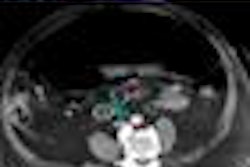NEW ORLEANS - A private cloud-based PACS has brought four competitive healthcare organizations together for the benefit of patients, while saving money in the process, according to a Tuesday presentation at the Healthcare Information and Management Systems Society (HIMSS) meeting.
Harrison Medical Center, Olympic Radiology, Advanced Medical Imaging, and the Doctors Clinic are participating in Northwest ImageShare, a cloud-based PACS that stores all images produced by the participants. In addition to lowering storage costs by at least 50% for the groups, the service facilitates image sharing and eliminates the need for duplicate imaging studies, according to Tyrel Walker, chief information officer at Harrison Medical Center, which led the project.
Walker presented Northwest ImageShare's early experiences during a HIMSS Knowledge Center session.
Prior to implementing Northwest ImageShare, Harrison Medical Center's emergency room (ER) physicians were often having difficulty accessing patient imaging studies conducted at other hospitals or imaging centers. This led to rescanning of the patient, incurring additional cost and exposure and slowing down diagnosis and treatment. It was also cumbersome in the hospital setting to deal with CDs from those ER patients who did bring those media with them, Walker said.
In addition, referring physician efficiency suffered from having to log in to multiple PACS interfaces from the various hospitals or imaging centers. Each entity in the community also spent quite a bit of money to keep their respective PACS up and running, he said.
Competitive concerns
As the competitors came together as a group to explore ways to provide better patient access, concerns naturally arose, primarily over protection of each organization's referral base. Other concerns included data security/privacy, how this information could all be stored in one location without the sharing of business information between the groups, how the system would work physically, how the migration of archived images would be handled, and how to deal with a loss of control over images, Walker said.
However, there were also positive aspects to consider, such as a significant expected financial benefit from pooling several hundred thousand exams in one location and working with a software provider to get the best discount, Walker said. In addition, having all imaging exams in the community stored on one PACS could reduce patient radiation exposure due to duplicate exams. With one entity hosting the PACS, centralized application support could be provided; only one PACS administrator was needed, he said.
Following a request for information (RFI) and then a request for proposal (RFP) process, the vendor was selected. As the leader in the project, Harrison Medical Center hosts the PACS at its data center and provides first-level support. The institution is also responsible for data migration and billing for the service.
The vendor (Sectra) is responsible for project management; PACS configuration, installation, and training; integration; and second-level support and remote monitoring, according to Walker. The company's Cross Platform Worklist tool performs queries across multiple databases and partitions each entity's patient database. When patients change providers, the new provider is granted access, but references to the referring physician's name are invisible to the new viewing entity.
Firewalled access
Northwest ImageShare provides each entity with access, separated by firewalls. The shared community PACS has yielded a number of key benefits, including efficient image access, reduced fees per study, and improved quality of care, while retaining local control of images, Walker said.
Because they only have to log in to one system, all physicians in the region now have fast, centralized access to images, regardless of where the image was acquired. This eliminates duplicate scans, improves quality of care, eliminates CDs, and provides a single PACS interface to use that can be accessed by mobile devices, Walker said.
The model also yields economies of scale, with at least a 50% reduction in storage costs.
"Where some of the groups were paying upward of $4 to $5 per exam, by pooling together several hundred thousand exams like we did, we were able to pass along and be very transparent to users about the $1.58 per study that we charge," Walker said.
That cost per study is the exact cost paid for the exam, so no profit is made by Harrison Medical Center from hosting the service.
Challenges with competitors
Walker offered a number of tips for overcoming competitive boundaries. First, it's important to have a natural leader in this process. As the largest group in the community, it was natural for Harrison Medical Center to be the leader on the project, he said.
They went to each imaging center in town that they wanted to be part of the initiative and discussed some of the challenges being faced by their ER physicians. As the conversation progressed over months, the decision was made to pursue the hosted system.
It's also important to collaborate with no egos, he said.
"We found it very easy to talk if we met in neutral locations," he said. "After all, we are all competitors in town, but we have one goal for patient safety."
C-level IT staff should be involved, and it's a good idea to market the service to other area radiology groups/hospitals so that nobody feels excluded, he said.
It's also helpful to perform a shared-services business case, demonstrating financial viability and return on investment, technical viability, and benefits to physicians, patients, and staff, Walker said.
Technical hurdles
Before proceeding with a shared hosted PACS like this one, it's important to address the IT network infrastructure and ensure that it can handle redundant connections to all groups.
"And then you clean up your network and make sure you that you can all connect easily," he said. "We had some consultants work with us to get our network prepared and work with the others groups to make sure they are prepared so that we could easily deploy."
While Harrison Medical Center found it easiest to host the system itself, this type of service could also be hosted elsewhere by a vendor at a data center. Harrison worked with its storage vendor to build a storage model that could scale up easily, Walker said.
The PACS must have this ability to scale and be capable of handling security/privacy issues, Walker said. Thanks to the system's integration with Microsoft's Active Directory service, each group is allowed to control access to their studies.
"So the hospital doesn't have to be involved day to day," he said.



















